The Georgia cottonmouth, known as the Agkistrodon piscivorus conanti, is one of the most feared and potentially deadly serpents in America’s southeastern states. If agitated or threatened, these venomous creatures can inflict a painful bite with consequences that could be fatal. But how common are these snakes, and when are they most active? Here are some facts and tips to help you stay safe around these aquatic pit vipers.
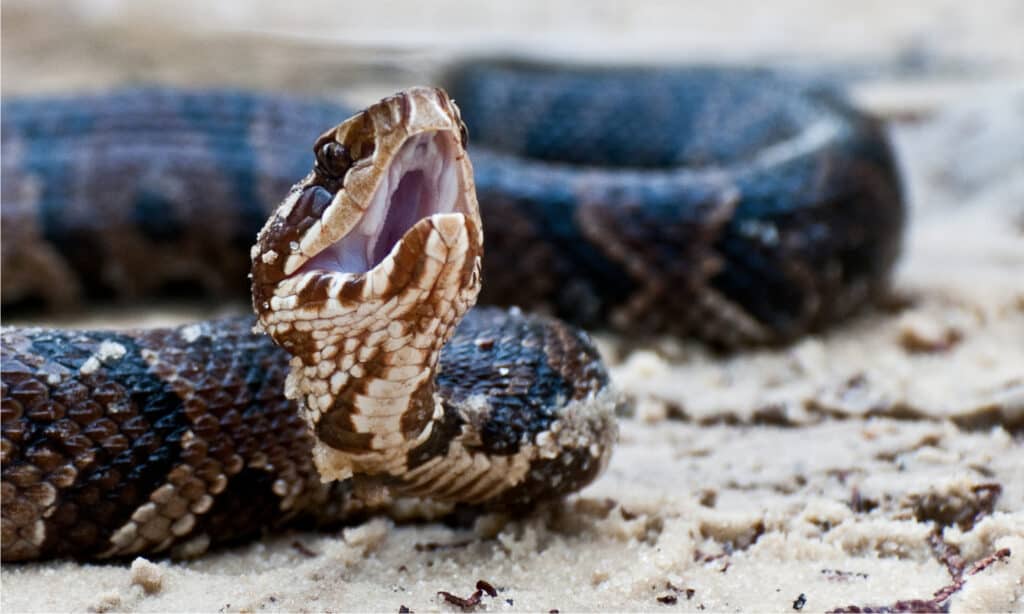
Georgia
cottonmouths have a distinctive appearance that helps them blend in with their surroundings.
©Jay Ondreicka/Shutterstock.com
What Are Georgia Cottonmouths?
Georgia cottonmouths (Agkistrodon piscivorus) are one of six species of venomous snakes native to Georgia. They belong to the same genus as copperheads, another common venomous snake in the region. They can be found near almost any natural body of water in the state, such as swamps, marshes, lakes, streams, and creeks. They’re capable of swimming in bays and estuaries. They can also cross between islands and the mainland.
Georgia cottonmouths have a distinctive appearance that helps them blend in with their surroundings. Their color varies from dark brown or black to olive, banded brown, or yellow. Some individuals have dark cross bands on their bodies that may fade with age. The cottonmouth gets its name from the white coloration inside its mouth, which it displays when threatened or agitated.
They have a triangular head with a white mouth that they display when threatened, hence their common name. They also have vertical pupils and heat-sensing pits on their snouts that help them locate prey.
Other Names
- Water moccasin
- Swamp moccasin
- Black moccasin
- Gaper
How Can You Tell Georgia Cottonmouth Apart From Other Water Snakes?
The cottonmouth is often confused with nonvenomous water snakes from the genus Nerodia that share similar habitats and behaviors. However, there are some ways to tell them apart:
- The cottonmouth has vertical (cat-like) pupils, while most water snakes have round pupils.
- The cottonmouth has dark stripes next to each nostril, while most water snakes don’t.
- The cottonmouth has keeled scales, while most water snakes have smooth scales.
If you encounter a snake near water that you cannot identify as nonvenomous, it’s best to leave it alone and keep your distance.
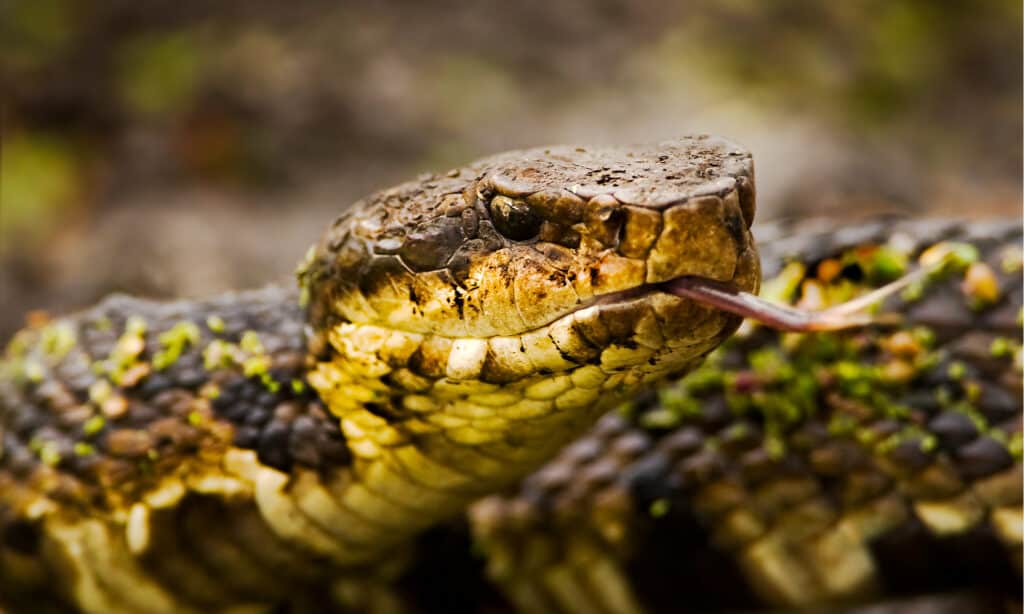
The cottonmouth has vertical (cat-like) pupils, while most water snakes have round pupils.
©Paul S. Wolf/Shutterstock.com
How Big Can Cottonmouths Get?
According to the Savannah River Ecology Laboratory, Cottonmouths are relatively large, ranging from 2 to 4 feet long (61 to 122 centimeters). However, most adults are between two and three feet long. However, some specimens can grow even bigger than that.
The longest cottonmouth recorded was a specimen measuring 74 inches (1.88 meters). It was captured near the Virginia-North Carolina border. Other reports of cottonmouths exceeding eight feet (2.44 meters) are unconfirmed and likely exaggerated.
What do Georgia Cottonmouths Eat?
Cottonmouths are semiaquatic snakes that can hunt both on land and in water. They are primarily nocturnal, meaning they hunt at night and rest during the day. Their flexible jaws allow them to consume prey larger than their heads. Georgia cottonmouths can swallow their prey whole or tear it into pieces. They can go for weeks or months without eating, depending on the food availability and the temperature of their environment.
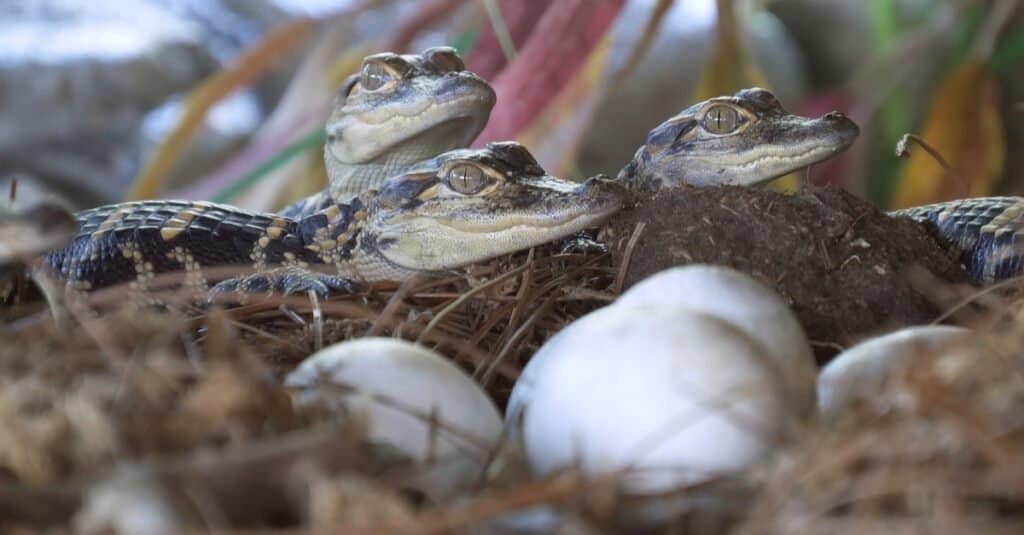
Georgia Cottonmouths eat a variety of food, including baby alligators.
©130392182/Shutterstock.com
Here are some of the common foods that Georgia Cottonmouths eat:
- Fish
- Frogs
- Salamanders
- Lizards
- Birds
- Rodents
- Other snakes (even smaller cottonmouths)
- Baby alligators
- Small mammals
When Are Georgia Cottonmouths Most Active?
The activity level of cottonmouths depends on several factors, such as temperature, humidity, seasonality, and reproduction. Cottonmouths are ectothermic animals that rely on external heat sources to regulate their body temperature. Therefore, they tend to be more active during warmer months (spring through fall) than colder months (winter).
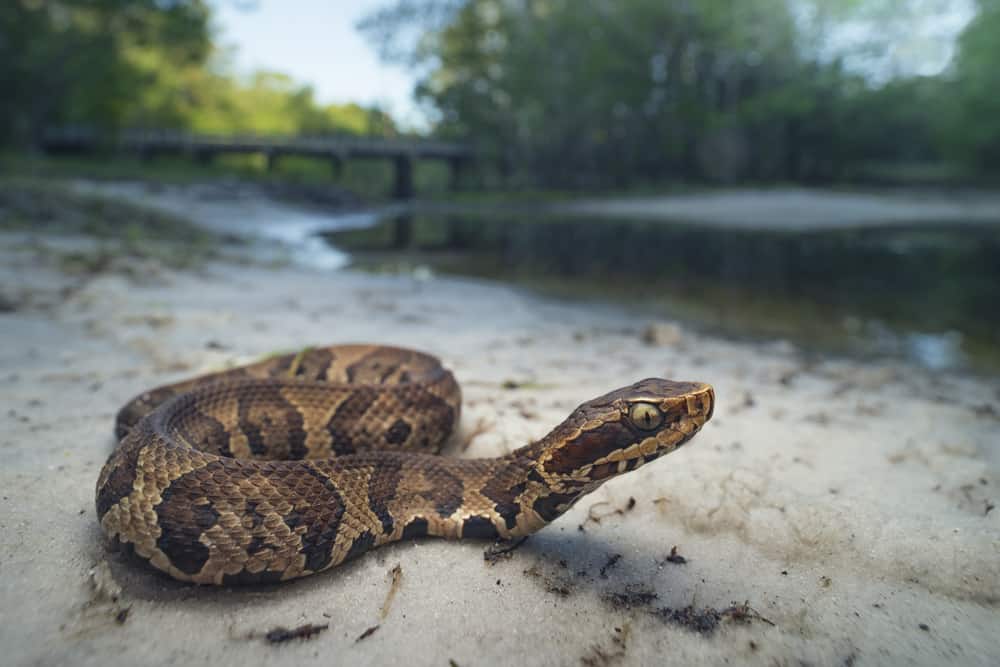
The activity level of cottonmouths depends on several factors, such as temperature, humidity, seasonality, and reproduction.
©Kristian Bell/Shutterstock.com
Winter Activity (December through February)
In winter (December through February), cottonmouths reduce their activity and metabolism and enter a dormancy called brumation. They find sheltered places to avoid freezing, such as under rocks or logs or inside caves. Sometimes they share these places with other snakes for warmth.
Spring Activity (March through May)
During spring (March through May), cottonmouths emerge from brumation and become more active as the weather warms up. This is also the mating season for cottonmouths when males compete for females by engaging in ritualized combat called “wrestling.” The winner gets to mate with the female while the loser retreats.
Summer activity (June through August)
Females give birth to 2 to 15 young ones per litter between late summer and early fall. During the summer months (June through August), cottonmouths continue to be active as they hunt for food and bask in sunny spots to raise their body temperature. They may also seek shade or water to cool down when it gets too hot. Cottonmouths are mostly nocturnal during this time of year when they can avoid predators and take advantage of cooler temperatures.
Fall activity (September through November)
Cottonmouths prepare for brumation during fall (September through November) by feeding more frequently and storing fat reserves for energy during winter. They may also move to lower elevations where it is warmer and more humid than higher elevations where it is colder and drier.
When Are Georgia Cottonmouths Most Aggressive?
Georgia cottonmouths are not naturally aggressive snakes. They prefer to avoid confrontation with humans or other potential predators. However, they may become defensive if they feel threatened or cornered. This may happen if you accidentally step on them or get too close to them while hiking, fishing, or camping near their habitat.
When threatened, Georgia cottonmouths will coil up their body and open their mouth wide to show off their white lining and fangs. A threat display is meant to warn off intruders before striking. However, not all Georgia cottonmouths will do this. Some may strike without warning if provoked enough.
Georgia cottonmouths may also become more aggressive during mating season (spring) when males compete for females or defend their territory from rivals.

Georgia cottonmouths are not naturally aggressive snakes.
©iStock.com/Chase D’animulls
Average Lifespan of Cottonmouths
The average lifespan of a cottonmouth snake is about ten years in the wild. However, they can live up to 20 years or more in captivity. The difference in lifespan is mainly due to the availability of food, water, shelter, and medical care in captivity versus the harsh conditions and predators in the wild.
How Dangerous Is A Cottonmouth Bite?
Contrary to popular belief, Georgia cottonmouths aren’t likely to attack humans unless they are provoked or disturbed.
Cottonmouths Have Potent Venom
Cottonmouths belong to the pit viper family, which means they have heat-sensing pits on their face that help them locate prey. They also have long fangs that can inject venom into their victims. Their venom is cytotoxic, which means it destroys cells. It can cause severe pain, swelling, bleeding, tissue damage, and even death if left untreated.
Cottonmouth Bites Are Rare, But Serious
According to research, cottonmouth bites account for less than 1% of snake bite deaths in the U.S., but they can still be life-threatening if not treated promptly and adequately. The symptoms of a cottonmouth bite may include intense pain at the bite site, swelling that spreads along the limb, bleeding from the wound and gums, nausea, vomiting, difficulty breathing, low blood pressure, shock, and organ failure.
Cottonmouth Bites Require Immediate Medical Attention
If you or someone you know is bitten by a cottonmouth snake (or any venomous snake), call 911 or get to the nearest hospital as soon as possible. Do not try to suck out the venom or apply ice or tourniquets to the wound; these methods can do more harm than good.
Will a Cottonmouth Chase You?
Some believe cottonmouths will chase humans if they encounter them, but this is a myth. Although it seems like the cottonmouth is chasing you, it’s trying to escape. It may also follow you because you’re blocking its path.
How to Avoid an Encounter with a Georgia Cottonmouth
The best way to avoid provoking a cottonmouth is to respect its habitat and keep your distance if you see one. Here are some tips to follow:
- Be aware of your surroundings when you visit areas where cottonmouths live.
- Wear sturdy shoes and long pants when hiking or walking near water sources.
- Don’t touch or handle any snake you encounter; it may be hard to tell if it is venomous.
- Don’t try to kill or capture a snake; this may provoke it into biting you.
- If you see a snake coiled up on land or floating on a water surface (a behavior called “rafting”), don’t approach it; it may be a cottonmouth ready to strike.
- If you hear a hissing sound coming from vegetation near water sources (a behavior called “gaping”), don’t investigate it; it may be a cottonmouth warning you away.
Are Georgia Cottonmouths Poisonous?
Cottonmouths are venomous, not poisonous. Venomous organisms inject their toxins into another animal by biting or stinging. In contrast, poisonous animals have toxins in their skin or other tissues that make them harmful or unpleasant to eat. Some examples of poisonous animals are poison dart frogs, pufferfish, and monarch butterflies. These animals typically have bright colors or patterns to warn predators of their toxicity.

Their venom is cytotoxic, which means it destroys cells. It can cause severe pain, swelling, bleeding, tissue damage, and even death if left untreated.
©joloei/Shutterstock.com
Can Humans Eat Cottonmouths?
Humans could theoretically eat it. However, there are some risks involved. The meat of cottonmouths may:
- Contain parasites or bacteria that could cause infections or diseases.
- Retain some traces of venom that could cause allergic reactions or poisoning.
- Taste unpleasant or bitter due to their diet of fish and amphibians.
Which Animals Prey On And Eat Cottonmouths?
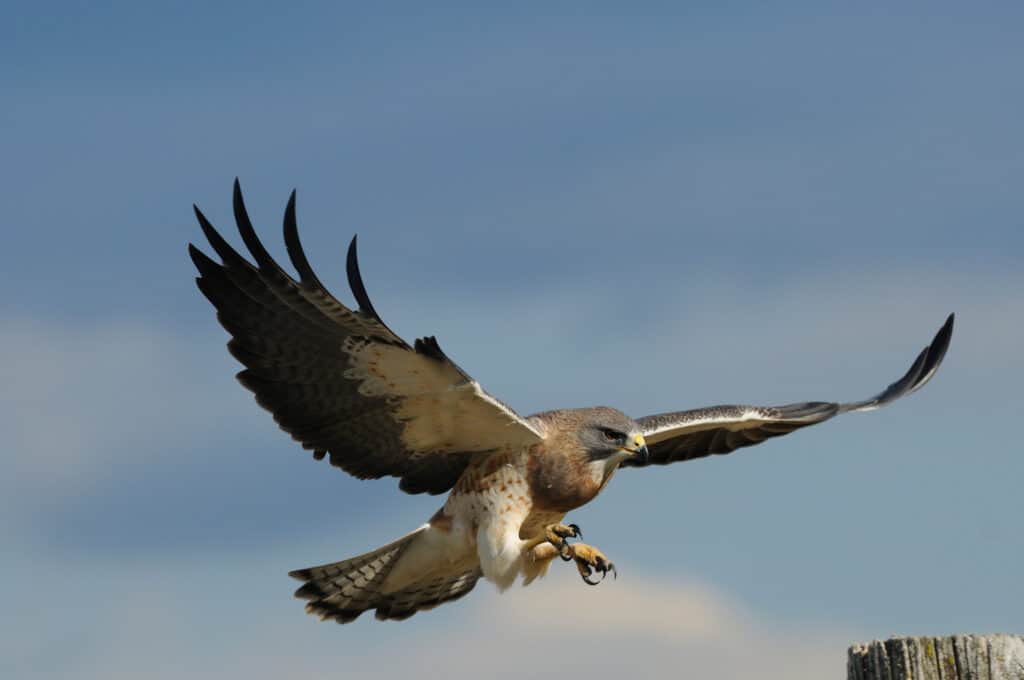
Some of the cottonmouths’ main predators are birds of prey, such as hawks.
©Rob McKay/Shutterstock.com
Some animals that prey on cottonmouths include:
Birds Of Prey
Some of the cottonmouths’ main predators are birds of prey, such as hawks, eagles, owls, and herons. These birds have keen eyesight and can spot a snake from a distance. They also have sharp talons and beaks that can pierce the snake’s skin and deliver a fatal blow.
Birds of prey usually hunt cottonmouths during the day, when the snakes are more active and basking in the sun. Some birds, such as owls, may also stalk them at night, using their superior hearing and vision to locate them.
Mammals
Some mammals can successfully hunt them down and feast on them. Raccoons, opossums, skunks, foxes, and coyotes are opportunistic carnivores that can prey on cottonmouths. These mammals have several adaptations that give them an edge over the snakes. They are faster, more agile, and have better senses of smell and hearing than cottonmouths. They can also use their teeth and claws to injure or kill the snake before it can strike back with its fangs.
Reptiles
Another group of animals that can prey on adult cottonmouths is reptiles. These include kingsnakes, alligators, and snapping turtles.
Reptiles usually hunt by ambush or stalking their prey until they get close enough to strike. Some reptiles may also use chemical cues or heat sensors to locate snakes hiding under vegetation or rocks. There have also been widespread reports of cannibalism by other cottonmouths.
These animals have adapted to deal with the venom of cottonmouths either by being immune to it or avoiding getting bitten.
Are Cottonmouths Endangered?
Cottonmouths are not endangered or threatened species. They have a large and stable population throughout their range. However, they still face threats from habitat loss, road mortality, illegal collection, and persecution by people who fear or dislike them.
In some states, cottonmouths are protected by law or have special status. For example, in Indiana, cottonmouths are state-endangered and have not been in several years. It’s likely that they no longer occur in Indiana.
Is It Legal To Kill A Cottonmouth in Georgia?
It’s legal to kill venomous snakes such as cottonmouths in Georgia. However, killing a snake should be a last resort, as most venomous snakes are harmless and beneficial to the ecosystem.
Killing a non-venomous snake, on the other hand, is illegal in Georgia and punishable by up to one year in jail and a $1,000 fine. Therefore, one should always try to identify the snake before acting. The best way to avoid conflict with snakes is to leave them alone and respect their space.
Can You Keep a Cottonmouth as a Pet?
Cottonmouths belong to the wildlife category under the law and are protected by it. To legally own one as a pet, you need a special permit from the Department of Natural Resources (DNR). However, cottonmouths are not easy to care for in captivity. They need a spacious enclosure that has both water and land areas. Cottonmouths require hiding spots and proper temperature and humidity levels. They also need a varied diet of live prey animals.
You should also know the ethical and environmental implications of keeping a wild animal as a pet. Cottonmouths play a vital role in their natural ecosystems by controlling rodent populations and providing food for other predators. Removing them from their habitats may disrupt the balance of nature and harm their conservation status.
How many Subspecies of Cottonmouths Live in The U.S.?
Three recognized subspecies of cottonmouths live in the U.S.:
- The eastern cottonmouth (Agkistrodon piscivorus piscivorus)
- The Florida cottonmouth (Agkistrodon piscivorus conanti)
- The western cottonmouth (Agkistrodon piscivorus leucostoma)
These subspecies differ in their geographic range, coloration, and size.
You can spot the eastern cottonmouth slithering around in states like Georgia, Virginia, North Carolina, and South Carolina. If you travel down to the Sunshine State, you might come across the Florida cottonmouth, which is limited to the Florida peninsula. The western cottonmouth inhabits several states, including Texas, Oklahoma, Illinois, and Indiana.
Final Thoughts on Georgia Cottonmouths
Georgia cottonmouths are more active and aggressive when they hunt for prey and seek mates in warmer months. Encounters with humans are rare but potentially dangerous, as cottonmouths will defend themselves if threatened. Understanding their behavior and habitat preferences allows us to coexist peacefully with these fascinating reptiles.
The photo featured at the top of this post is © Nathan A Shepard/Shutterstock.com
Discover the "Monster" Snake 5X Bigger than an Anaconda
Every day A-Z Animals sends out some of the most incredible facts in the world from our free newsletter. Want to discover the 10 most beautiful snakes in the world, a "snake island" where you're never more than 3 feet from danger, or a "monster" snake 5X larger than an anaconda? Then sign up right now and you'll start receiving our daily newsletter absolutely free.
Thank you for reading! Have some feedback for us? Contact the AZ Animals editorial team.






